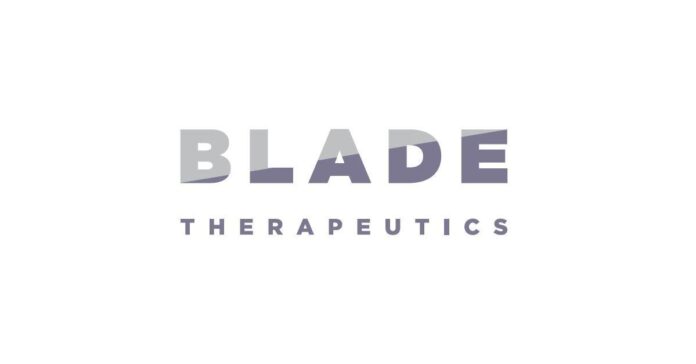SOUTH SAN FRANCISCO, Calif.– Blade Therapeutics, Inc., a biopharmaceutical company focused on developing cutting-edge treatments for debilitating fibrotic and neurodegenerative diseases, today announced encouraging data from phase 1 and preclinical DDI studies of cudetaxestat, an investigational non-competitive autotaxin inhibitor in clinical development for IPF and other fibrotic diseases. These data were featured in poster presentations at the American Thoracic Society (ATS) 2022 International Conference, taking place May 13-18, 2022, at the Moscone Center, in San Francisco.
“These positive results from clinical and preclinical drug-drug interaction studies reinforce our confidence in the potential to co-administer cudetaxestat on top of currently approved IPF therapies in clinical studies of patients with IPF,” said Wendye Robbins, M.D., president and CEO of Blade. “With an extensive phase 1 clinical program now complete, we are ready to start a planned phase 2 clinical trial of cudetaxestat for the treatment of IPF in the second quarter of 2022.”
The phase 1 drug-drug interaction study assessed the effect of cudetaxestat 750mg on the pharmacokinetics (PK) of two approved drugs for IPF – pirfenidone and nintedanib – in 83 healthy adult volunteers who completed the study (NCT04814498). Results of the study showed:
- Neither nintedanib nor pirfenidone significantly alter the exposure of cudetaxestat;
- Cudetaxestat does not affect the PK of pirfenidone;
- Cudetaxestat does not significantly increase the exposure of nintedanib (AUC(0-12));
- Most common treatment-related adverse events were mild gastrointestinal upset (diarrhea and nausea); and
- There were no treatment-related serious adverse events.
Study data were presented along with results from three additional phase 1 clinical studies of cudetaxestat in a poster (#420 –) titled “Clinical Evaluation of Cudetaxestat for Safety, Tolerability, Pharmacokinetics, Pharmacodynamics, and Potential Drug-Drug Interactions.”
The preclinical study was designed to understand whether the plasma concentration of nintedanib, which is a P-glycoprotein (P-gp) substrate, is altered when co-administered at steady state with either cudetaxestat or GLPG-1690 (ziritaxestat), an investigational competitive inhibitor of autotaxin. Results of the study conducted in a rat model showed:
- Ziritaxestat is a potent inhibitor (single-digit micromolar IC50 values) of P-gp when either quinidine or nintedanib is used as a substrate, and cudetaxestat is a weak P-gp inhibitor under similar conditions;
- Ziritaxestat significantly increased nintedanib exposure when co-administered in vivo in rats.
- Cudetaxestat did not alter nintedanib exposure when co-administered in vivo in rats; and
Study data were presented in a poster (#P424) titled “Preclinical Evaluation of Cudetaxestat (BLD-0409) for Potential Drug-Drug Interactions (DDI’s).” Information about the ATS poster session.
Toby Maher, M.D., Ph.D., professor of medicine at USC Hastings Center for Pulmonary Research, Los Angeles, said, “There is a huge unmet need for new antifibrotic therapies which can complement current treatments and potentially provide greater benefit for patients in need of new treatment options. I look forward to collaborating with Blade as it advances the clinical development of this investigational therapy.”
Cudetaxestat (BLD-0409), a non-competitive, reversible inhibitor of autotaxin, has demonstrated direct anti-fibrotic activity and differentiating preclinical and biochemical characteristics which support the potential for a treatment profile in lung and liver fibrosis. Available data from four completed phase 1 studies in more than 200 healthy volunteers showed that cudetaxestat was well tolerated with a demonstrated pharmacokinetic/pharmacodynamic correlation and biomarker activity. Cudetaxestat has been granted orphan drug designations in the treatment of IPF and systemic sclerosis. Cudetaxestat is an investigational medicine that is not approved for commercial use by the FDA or any other regulatory authority.
Pro-fibrotic processes are stimulated by autotaxin, a key enzyme responsible for generating the potent signaling lipid lysophosphatidic acid (LPA). Excessive autotaxin levels and activity play a central role in various fibrotic diseases and occur in response to epithelial cell/tissue damage, leading to elevated levels of LPA. LPA binds to LPA receptors on myofibroblasts triggering a signaling cascade that leads to myofibroblast activation/differentiation. Activated myofibroblasts produce extracellular matrix proteins that make up the fibrotic lesion (organ/tissue scarring). Increased autotaxin levels and activity are associated with liver, lung, kidney, and skin fibrosis. In addition, autotaxin levels correlate with fibrosis severity in various liver diseases (e.g., nonalcoholic fatty liver disease/nonalcoholic steatohepatitis (NASH)). Inhibition of the autotaxin-LPA pathway has been clinically validated in IPF.
Fibrosis is a complex, pathologic process involving the development of organ/tissue scarring characterized by deposition of extracellular matrix proteins that develop in response to aberrant cell/tissue damage. Excessive fibrosis disrupts normal architecture and function of organs/tissues. Later-stage fibrotic disease is marked by poor outcomes and high morbidity and mortality. Diseases characterized by uncontrolled, progressive fibrosis include IPF, interstitial lung disease, and NASH. New well-tolerated therapies that provide robust attenuation of disease progression are needed to address the high burden of fibrotic diseases.


